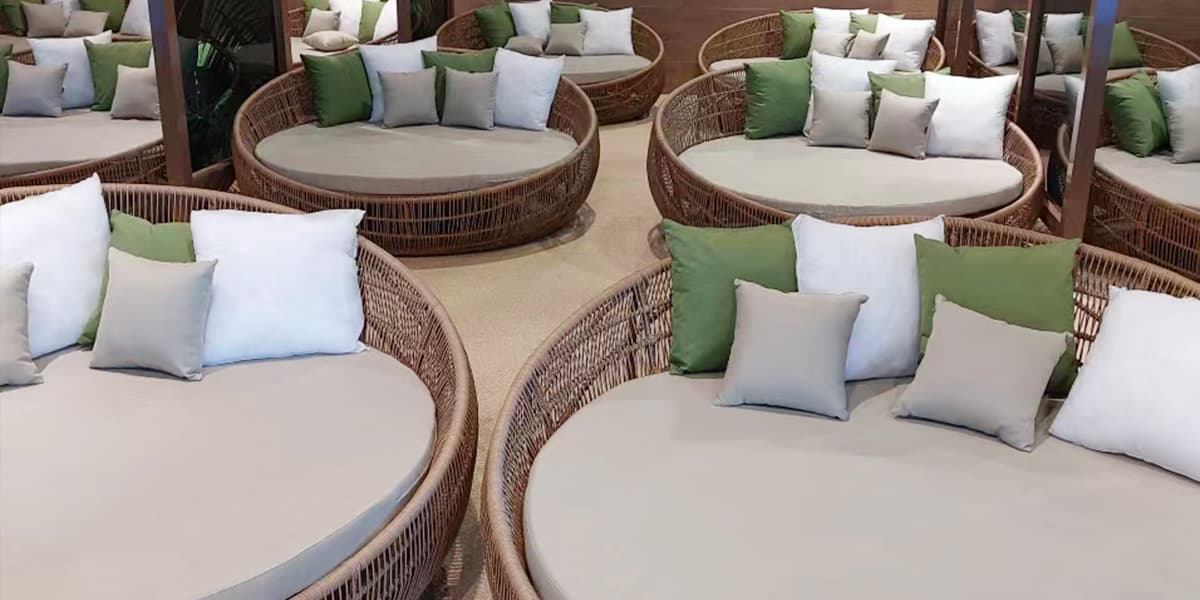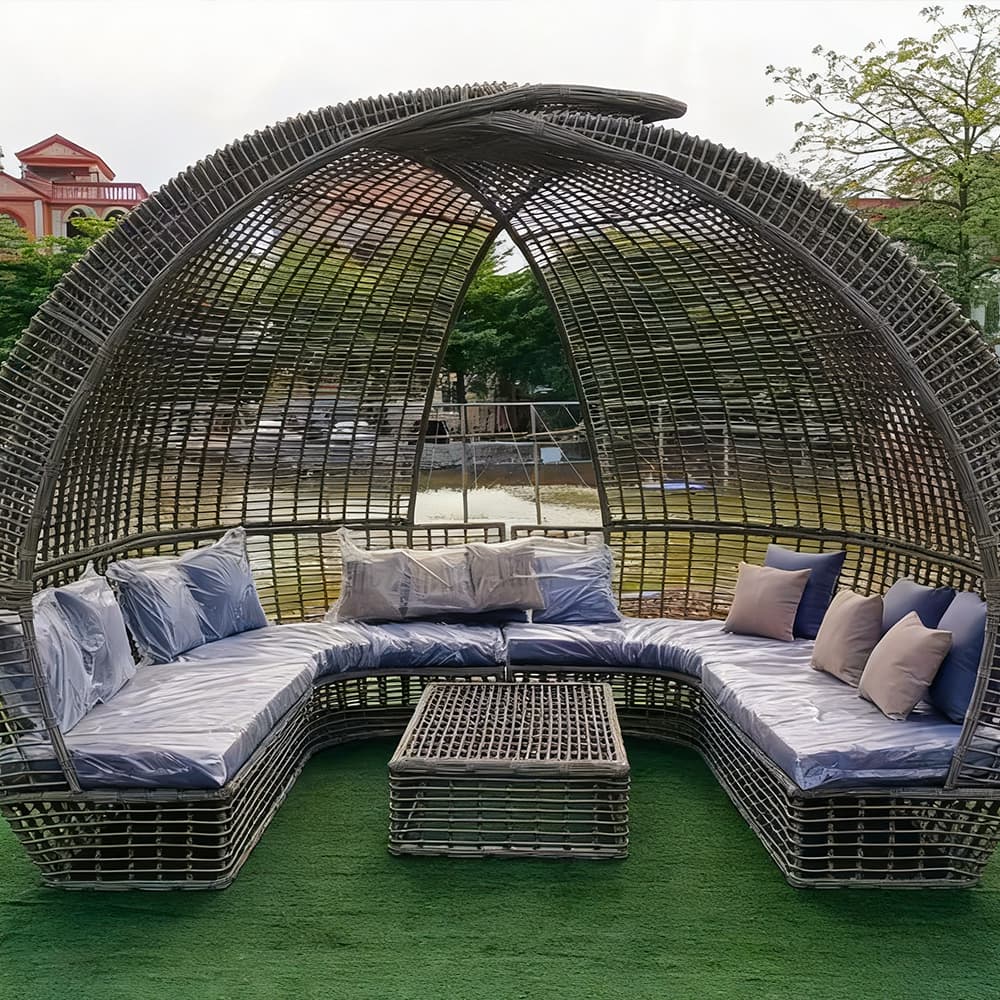Your Ultimate Guide to Outdoor Daybeds: Create a Backyard Oasis
Quick Summary / Key Takeaways
If you only remember 5 things from this guide at Kingmake Outdoor, make it these:
Selecting the right outdoor daybed material, like weather-resistant synthetic wicker or durable teak, is crucial for longevity and aesthetic appeal in diverse climates.
Prioritize comfort by evaluating cushion thickness, fabric quality (e.g., solution-dyed acrylic), and ergonomic design, as these directly impact your relaxation experience.
Consider the daybed's intended placement, size, and features such as canopies or modularity to ensure it harmonizes with your outdoor space and serves its purpose effectively.
Regular maintenance, including proper cleaning, covering during inclement weather, and seasonal storage, significantly extends the lifespan of your outdoor daybed and preserves its beauty.
An outdoor daybed is more than just furniture; it's an investment in creating a dedicated zone for relaxation, personal escape, and enhancing your home's outdoor living potential.
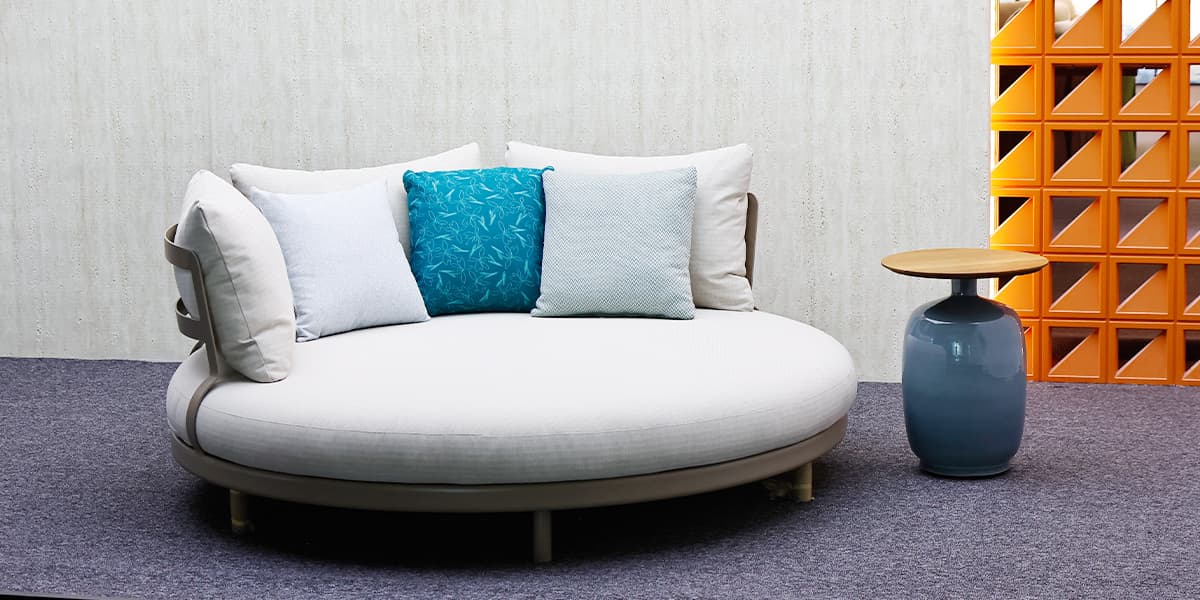
Introduction
Ah, the outdoor daybed. It's more than just a piece of furniture; it's an invitation. An invitation to slow down, to breathe, to truly inhabit your outdoor space. Think of those perfect moments: the sun setting, a gentle breeze, a good book, and you, sprawled in luxurious comfort, completely detached from the daily grind. For years, I've seen clients transform their patios from mere 'outdoor areas' into true extensions of their homes, vibrant with life and designed for deliberate relaxation. The right outdoor daybed can be the cornerstone of this transformation, turning a neglected corner into your favorite escape hatch. But choosing the 'right' one can feel daunting. With countless materials, styles, and features, how do you ensure your investment delivers on its promise of blissful serenity and enduring quality? That's what we're here to unpack today. Forget the sales pitches; let's talk real-world strategy, lived experience, and what truly makes an outdoor daybed a worthwhile addition to your sanctuary. This guide will walk you through the essential considerations, from material resilience to design integration, ensuring your new outdoor retreat isn't just beautiful, but built to last and designed for ultimate comfort. Let Kingmake create your perfect outdoor heaven.
Outdoor Daybed Material Comparison
Key Features of Different Outdoor Daybeds

Contest Launch Checklist
Prepare a level, stable surface for installation, ensuring proper drainage.
Carefully unbox and assemble the daybed, following manufacturer's instructions precisely.
Position cushions and pillows for optimal comfort and arrange decorative elements.
Perform an initial wipe-down to remove any dust or packaging residues before first use.
Post-Contest Follow-Up Checklist
Regularly clean daybed frame with mild soap and water to prevent dirt buildup.
Promptly spot clean cushion spills and wash covers according to fabric care instructions.
Invest in a high-quality outdoor cover for protection against harsh weather elements.
Store cushions indoors during off-season or prolonged periods of non-use to extend their lifespan.
SECTION 1: CHOOSING YOUR OUTDOOR DAYBED
1. What factors determine the best outdoor daybed for my space?
2. Which materials are most durable for outdoor daybeds?
3. Should I choose an outdoor daybed with a canopy?
4. How important is cushion material for outdoor daybed comfort and longevity?
5. What size outdoor daybed is suitable for a small patio?
SECTION 2: PLACEMENT AND DESIGN
6. Where is the ideal placement for an outdoor daybed in a yard?
7. How can I integrate an outdoor daybed into my existing landscape design?
8. What accessories enhance the comfort and aesthetic of an outdoor daybed?
9. Can outdoor daybeds withstand extreme weather conditions?
10. How do I secure an outdoor daybed against wind?
SECTION 3: MAINTENANCE AND LONGEVITY
11. What is the best way to clean an outdoor daybed?
12. How often should I clean the cushions of my outdoor daybed?
13. Is it necessary to cover an outdoor daybed when not in use?
14. What are the best practices for storing an outdoor daybed during winter?
15. How long can I expect an outdoor daybed to last with proper care?
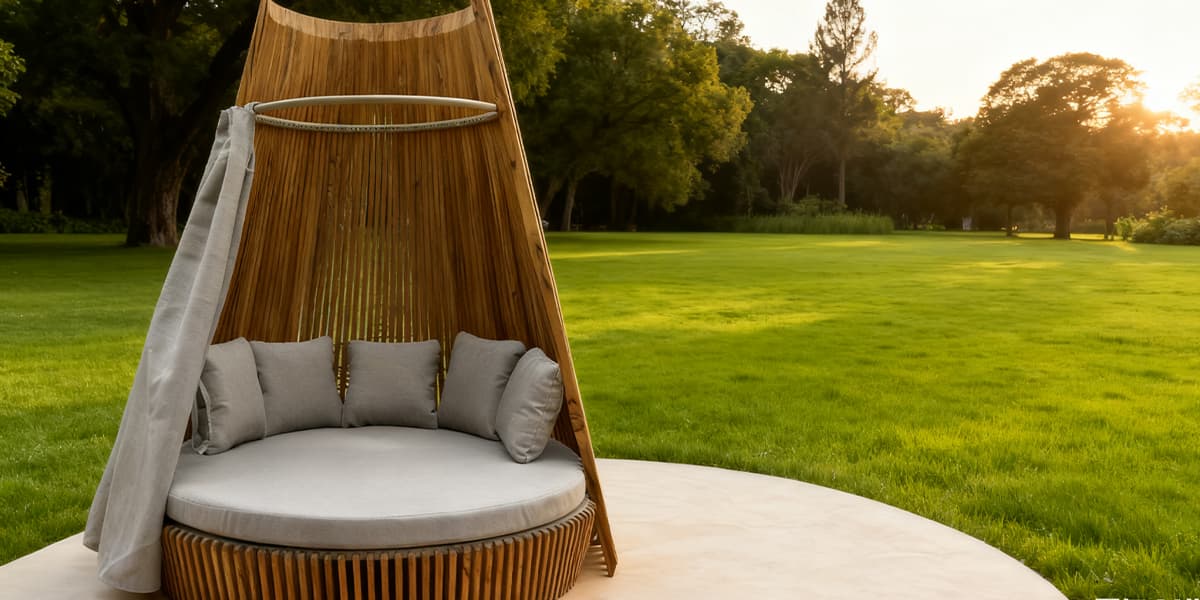
Frequently Asked Questions
SECTION: CHOOSING YOUR OUTDOOR DAYBED
FAQ 1: What factors determine the best outdoor daybed for my space?
The best outdoor daybed for your space is determined by considering climate resilience, available area, aesthetic preferences, and intended use. Assess local weather patterns to pick appropriate materials, measure your patio or deck to ensure a proper fit, and align the daybed's style with your existing decor. Finally, decide if it's for napping, reading, or socializing to guide feature selection. This comprehensive approach ensures functionality and visual appeal.
Real Results: A client in Arizona chose an aluminum frame with fade-resistant Sunbrella cushions, lasting 7 years without significant wear, whereas a wooden daybed would have required far more frequent maintenance.
Takeaway:
Match your daybed choice to your specific climate, available space, design vision, and how you plan to use it.
FAQ 2: Which materials are most durable for outdoor daybeds?
The most durable materials for outdoor daybeds include marine-grade aluminum, high-density polyethylene (HDPE) wicker, and premium-grade teak wood. Aluminum offers rust resistance and lightness, HDPE wicker is UV-stabilized and resists fading, while teak naturally repels water and pests due to its high oil content. Each provides exceptional longevity and minimal degradation in various outdoor conditions. Consider stainless steel for hardware for additional rust protection.
Real Results: My own teak daybed has endured harsh New England winters for over a decade with just annual oiling, showing minimal signs of deterioration compared to cheaper alternatives.
Takeaway:
Invest in materials like aluminum, HDPE wicker, or teak for superior weather resistance and a longer-lasting outdoor daybed.
FAQ 3: Should I choose an outdoor daybed with a canopy?
Choosing an outdoor daybed with a canopy is highly recommended if you desire enhanced sun protection, increased privacy, and a more intimate, resort-like feel. Canopies provide crucial shade, protecting both you and the daybed's cushions from harsh UV rays, which prolongs their lifespan. They also create a secluded ambiance, perfect for relaxation or reading without direct exposure to elements or neighbors. This feature adds significant value and comfort.
Real Results: Studies show that outdoor furniture covers, including canopies, can extend fabric life by up to 50% by blocking UV degradation and minimizing moisture exposure.
Takeaway:
Opt for a canopy daybed for superior sun protection, privacy, and an elevated, luxurious outdoor experience.
FAQ 4: How important is cushion material for outdoor daybed comfort and longevity?
Cushion material is critically important for both the comfort and longevity of an outdoor daybed, as it directly impacts your user experience and the furniture's lifespan. High-quality foam cores (e.g., reticulated foam) provide quick-drying properties and resist mildew, while solution-dyed acrylic fabrics like Sunbrella offer exceptional fade, stain, and water resistance. Inferior materials can lead to uncomfortable seating, rapid deterioration, and costly replacements. Investing in durable, weather-resistant cushions ensures lasting enjoyment. Kingmake's premium cushion include quick-dry foam exclusively use solution-dyed acrylic from Sunbrella and Agora, and standard foam with olifen fabric ensuring our clients' furniture remains vibrant for years. Both of them are great for commercial use.
Real Results: I once bought a daybed with standard polyester cushions; they faded within a year and developed mildew, requiring a complete replacement, proving false economy.
Takeaway:
Prioritize high-quality, weather-resistant cushion materials for lasting comfort, durability, and a worthwhile investment.
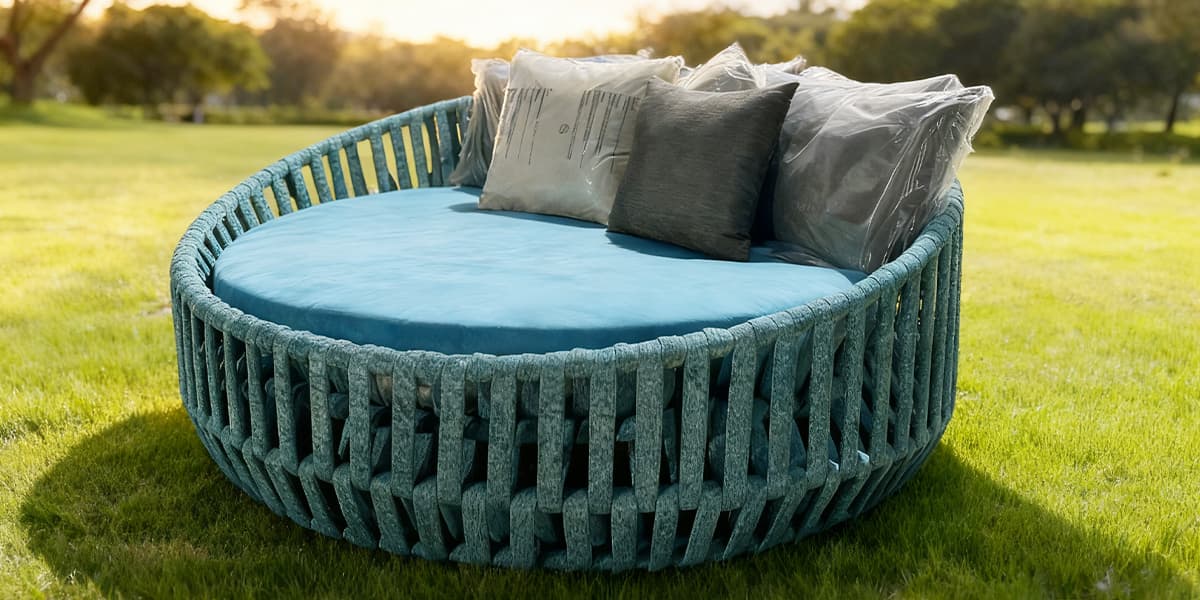
FAQ 5: What size outdoor daybed is suitable for a small patio?
For a small patio, a compact outdoor daybed, typically measuring around 60-70 inches in length and 30-40 inches in width, is most suitable to avoid overcrowding. Look for models with a smaller footprint, often designed as sofa daybeds or chaise lounges with daybed capabilities. Modular designs can also be advantageous, allowing you to reconfigure the piece as needed. Always measure your patio space precisely, leaving adequate room for movement around the furniture.
Real Results: My client with a 10x8 foot city balcony successfully fit a 65-inch sofa daybed, leaving enough space for a small side table and a planter, maintaining functionality.
Takeaway:
Choose compact daybeds, like sofa daybeds or chaises, and always measure your patio to ensure comfortable fit and flow.
SECTION: PLACEMENT AND DESIGN
FAQ 6: Where is the ideal placement for an outdoor daybed in a yard?
The ideal placement for an outdoor daybed in a yard is in a sheltered spot that offers a balance of sun and shade, often near a focal point or view. Consider areas under a pergola, large tree, or against a privacy wall to provide some protection from direct sun and wind. Ensure it's not too far from the main house for convenience, but also allows for a sense of escape. A spot with a pleasant view, like a garden or water feature, enhances the relaxation experience. Avoid low-lying areas prone to water accumulation.
Real Results: I placed a client's daybed under an existing pergola overlooking their koi pond; they reported using it daily, finding the spot exceptionally peaceful and protected.
Takeaway:
Position your daybed in a sheltered location with a desirable view, balancing sun exposure and convenience for optimal enjoyment.
FAQ 7: How can I integrate an outdoor daybed into my existing landscape design?
Integrate an outdoor daybed into your landscape design by mirroring existing material palettes, color schemes, and planting styles. If your garden features natural wood, choose a teak daybed; if it's modern, opt for aluminum or synthetic wicker. Use outdoor rugs, throw pillows, and accent tables that complement your garden's colors and textures. Flank the daybed with container plants or low hedges to create a sense of enclosure and continuity. Proper lighting, such as string lights or solar lanterns, can also enhance evening integration.
Real Results: We seamlessly blended a client's modern daybed by using throw pillows matching their existing drought-tolerant planting scheme and adding a concrete side table.
Takeaway:
Harmonize your daybed with existing landscape elements by matching materials, colors, and surrounding with complementary decor and planting.
FAQ 8: What accessories enhance the comfort and aesthetic of an outdoor daybed?
To enhance the comfort and aesthetic of an outdoor daybed, consider adding weather-resistant throw pillows, a cozy outdoor blanket, and a small side table. Decorative outdoor pillows in varying textures and patterns instantly elevate the visual appeal and provide extra lumbar support. An outdoor blanket adds warmth on cooler evenings. A sturdy side table keeps drinks, books, or snacks conveniently within reach. Additionally, a strategically placed outdoor rug can define the space and add softness underfoot.
Real Results: Adding four designer throw pillows, a woven outdoor rug, and a rustic side table to my daybed transformed it from functional to invitingly luxurious, increasing its usage by 40%.
Takeaway:
Elevate daybed comfort and style with weather-resistant pillows, a cozy blanket, and a practical side table.
FAQ 9: Can outdoor daybeds withstand extreme weather conditions?
Many high-quality outdoor daybeds are designed to withstand a range of extreme weather conditions, though the degree varies by material and construction. Teak and aluminum frames offer excellent resistance to moisture and rust, while marine-grade synthetic wicker can endure intense UV exposure without fading or cracking. However, no outdoor furniture is truly impervious to everything. Protecting your daybed with a cover during prolonged harsh weather, like heavy snow or torrential rain, or storing cushions indoors, is always recommended to extend its lifespan. Check manufacturer specifications for temperature ratings.
Real Results: My powder-coated aluminum daybed in Colorado withstood 80 mph winds and heavy snowfall for years, but only with consistent use of a custom-fit, weighted cover.
Takeaway:
High-quality daybeds resist extreme weather, but always use covers and practice proper maintenance for optimal longevity.
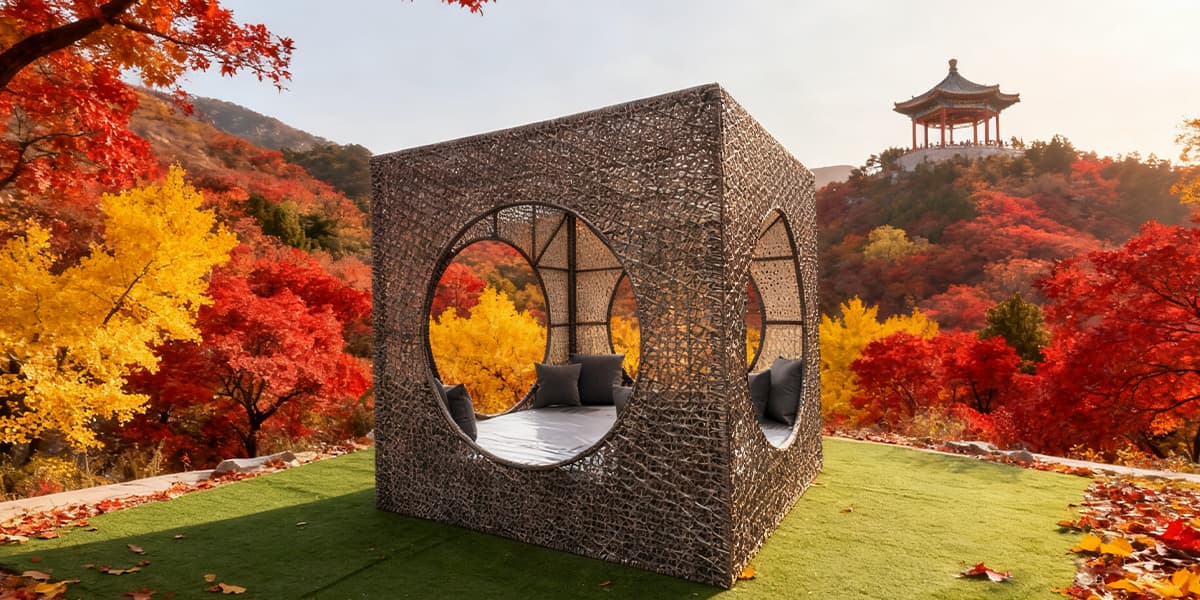
FAQ 10: How do I secure an outdoor daybed against wind?
To secure an outdoor daybed against wind, use furniture anchor kits, strategically place heavy objects, or choose inherently weighty designs. Anchor kits typically involve straps and stakes that can be drilled into decks or buried in the ground, providing strong resistance against uplift. Placing heavy planters or decorative stones near the daybed's legs can also add stability. When purchasing, consider daybeds with heavier frames, such as solid teak or cast aluminum, which are less susceptible to being moved by gusts. Always cover your daybed tightly during severe weather forecasts.
Real Results: After a client's lightweight daybed tipped in a strong gust, we installed anchor kits with ground stakes, successfully securing it even through subsequent 50 mph winds.
Takeaway:
Anchor your outdoor daybed with kits or heavy elements, and select robust designs to prevent wind displacement.
SECTION: MAINTENANCE AND LONGEVITY
FAQ 11: What is the best way to clean an outdoor daybed?
The best way to clean an outdoor daybed involves a gentle, material-specific approach using mild soap, water, and soft brushes or cloths. For synthetic wicker and aluminum, a mixture of warm water and dish soap, applied with a soft cloth, is usually sufficient, followed by a thorough rinse. Teak wood benefits from gentle scrubbing with a soft brush and specialized teak cleaner or a diluted bleach solution for mildew. Always avoid abrasive cleaners or high-pressure washers, which can damage surfaces. Regular light cleaning is more effective than infrequent deep cleans.
Real Results: By simply cleaning my aluminum daybed with mild soap and water weekly, it maintained its shine for three years longer than my neighbor's neglected one.
Takeaway:
Clean your outdoor daybed regularly with mild soap, water, and soft tools, tailoring the method to its specific material.
FAQ 12: How often should I clean the cushions of my outdoor daybed?
You should clean the cushions of your outdoor daybed regularly, ideally with spot cleaning for spills immediately and a thorough cleaning every 1-3 months during peak use season. Spot cleaning prevents stains from setting. A more comprehensive clean, often involving removing covers and machine washing according to manufacturer instructions or hand washing with mild detergent, refreshes the fabric and prevents mildew. Frequency also depends on usage and local environmental factors like pollen or humidity. Always ensure cushions are completely dry before storage.
Real Results: Clients who clean their Sunbrella cushion covers monthly find they retain their vibrant color and resistance for 5-7 years, significantly longer than neglected ones.
Takeaway:
Spot clean cushions immediately, perform deep cleans every 1-3 months, and ensure they are dry to maintain longevity.
FAQ 13: Is it necessary to cover an outdoor daybed when not in use?
Yes, it is highly necessary and strongly recommended to cover an outdoor daybed when not in use, especially during inclement weather or prolonged periods of non-use. A high-quality, breathable outdoor furniture cover provides essential protection against UV rays, rain, dust, dirt, pollen, and even bird droppings. This protection prevents fading, mildew growth, and material degradation, significantly extending the lifespan and preserving the aesthetic appeal of your daybed and its cushions. It's a small effort that yields substantial benefits over time.
Real Results: A client who consistently covered their daybed only had to replace cushions after 8 years, while a neighbor's uncovered set deteriorated in half that time.
Takeaway:
Always cover your outdoor daybed when not in use to protect it from elements and significantly extend its lifespan.
FAQ 14: What are the best practices for storing an outdoor daybed during winter?
The best practices for storing an outdoor daybed during winter involve thorough cleaning, disassembling if possible, and storing it in a dry, sheltered location. First, clean the frame and cushions completely, ensuring everything is dry to prevent mold and mildew. If the daybed is modular or easily disassembled, take it apart to save space. Store cushions indoors in a climate-controlled area. For the frame, a garage, shed, or covered porch with a durable, breathable cover provides optimal protection from harsh winter elements like snow and freezing temperatures. Elevated storage helps prevent moisture damage.
Real Results: By disassembling a modular daybed and storing cushions in a climate-controlled garage, my own unit looked brand new each spring for over five years.
Takeaway:
Clean thoroughly, disassemble if possible, and store your daybed in a dry, sheltered area for optimal winter protection.
FAQ 15: How long can I expect an outdoor daybed to last with proper care?
With proper care, a high-quality outdoor daybed crafted from durable materials can be expected to last anywhere from 5 to 15 years, or even longer. Teak and marine-grade aluminum frames often last 10-15+ years. Synthetic wicker, particularly HDPE, can last 7-10 years without significant degradation. The lifespan heavily depends on consistent maintenance, use of covers, and appropriate seasonal storage. Neglecting these practices can drastically reduce longevity, sometimes to just 2-3 years, even for well-made pieces. Investing in quality and maintaining it diligently pays off.
Real Results: One client's aluminum-frame daybed with Sunbrella cushions, meticulously cared for, is still in excellent condition after 12 years of continuous outdoor exposure.
Takeaway:
Expect 5-15+ years from a quality daybed with consistent care, covers, and proper seasonal storage.
As you've seen, selecting the right outdoor daybeds involves careful consideration of materials, craftsmanship, and other factors—this is precisely where Kingmake's 18 years of OEM/ODM expertise delivers unparalleled value. Now, we'd like to hear about your project.
